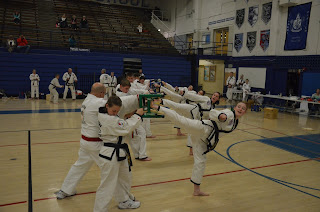By Brain O'Reilly, purple belt, CTI BBC Member
On any given team, is any one person more important? Why?
This is a question of team roles not people. Teams consist of individuals with unique skill sets, strengths and weaknesses. The role that an individual plays can vary based on the mission and long-term goal(s) of the team or the short-term task at hand. Often the roles are predetermined; based on job description, hierarchy, experience, specialty, etc. Often those predetermined roles fit well with an individual’s current level of expertise, seniority and skill-set. Yet roles within a team are rarely static. As people gain more experience and responsibility they move up in the team and as others fail to maintain their current role they move down or out of the organization. Teams need leaders, and leaders need followers; it is symbiotic. A lone leader is not a team and a team without a leader is lost and often disbands. One can argue that an effective team leader is the most important role on a team. Leadership team roles are replicated in nature because they effectively ensure the survival of the team. For example; wolf packs have an alpha male and as he loses the ability to protect, provide and lead, a new leader rises from the pack to replace him. The wolf pack also has an Alpha Female, protecting and nurturing the upcoming Alpha’s and the rest of the pack. Individuals/people are replaceable, but roles are rarely replaceable. It’s easier for a good leader to find a team and take it to the next level than it is for a mediocre team to find a good leader. All members are important, but the immediate strength of the team is built around its leadership and then the quality and growth of upcoming members. The X-Factor that complements strong leadership and strong membership is the empowerment of members with unique skills sets to experiment and expand opportunities to the pack which then takes the team to a new and higher level of productivity and competition.
How can people achieve more whey they work together?
There is a compounding effect to team work. A team’s resources and portfolio of wealth are built around its active participants. The rich get richer because they have more resources to work with and they invest those resources with greater effectiveness. Productive members learn from the success and diversity of others, tapping into those resources and expanding their own skill sets and contributions to the team.Each positive individual contribution is multiplied by other members and then reinvested as the team attracts more investors and new opportunities.Like any wise investment, the greater the resources the greater the return and the greater the ability to reinvest. High productivity and success offers the luxury of experimentation and investment in new disciplines which then leads to a new and higher level of growth. The active individual shareholder of a team who adds to the value of the team also adds to the health of his/her own individual portfolio of resources. A healthy individual and team can perform at a higher level of output and then continue to grow beyond its “less-healthy” competitors.The healthy ideal for growth and productivity relies on each contributing share or each contributing team member; expanding individually and for the benefit of the team. “...A team of the people, for the people, by the people.” –Abe Lincoln

No comments:
Post a Comment